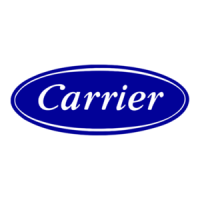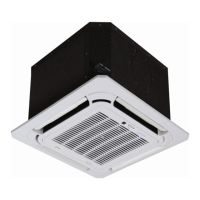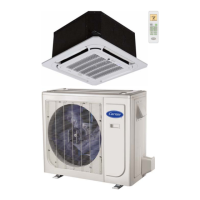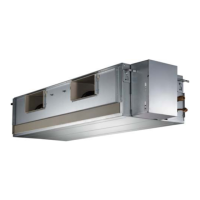10. FOLLOWING SYMPTOMS ARE NOT AIR
CONDITIONER TROUBLES
Symptom 1: The system does not operate
The air conditioner does not start immediateHy after the ON/OFF
button on the roemote controHHeris pressed.
Hfthe operation HampHghts, the system's functions are noraml.
in normaHcondition.To prevent overHoading of the compressor
motor, the air conditioner starts 3 minutes after it is turned ON.
Hfthe operation Hamp and the "PRE-DEF indicator(cooHing and
heating type) or fan onHy indicator(cooHing onHy type)" Hight, it
means you choose the heating modeH, When just starting, if the
compressor has not started, the indoor unit dispHays "anti coHd
wind" protection message because of its overHow outlet temperature.
Symptom 2: Change into the fan mode during cooling
mode
[] to prevent the indoor evaporator from frosting, the system
change into to modes automatically, returns to the cooHing
mode soon after.
When the room temperature drops to the set temperature, the
compressor goes off and the indoor unit changes to fan mode;
when the temperature increases, the compressor starts again. Ht
is the same for in the heating mode.
Symptom 3: White mist comes out of a unit
Symptom 3.1: Indoor unit
When the humidity is high during the cooHing operation and if the
interior of an indoor unit is extremeHy contaminated, the temperature
distribution inside a room becomes uneven. Htis then necessary to
cHeanthe interior of the indoor unit. Ask your deaHerfor detaiHs on
cHeaning the unit. This operation requires a quaHified service person.
Symptom 3.2: indoor unit, outdoor unit
When the humidity is high during the cooHing operation and if the
interior of an indoor unit is extremeHy contaminated, the temperature
distribution inside a room becomes uneven. Htis then necessary to
cHeanthe interior of the indoor unit. Ask your deaHerfor detaiHs on
cHeaning the unit. This operation requires a quaHified service person.
[] When the system is changed over to a heating operation after
adefrost operation, Moisture generated by defrost becomes
steam and is exhausted.
Symptom 4: Noise of air conditioners cooling
Symptom 4.1 : indoor unit
A continuous How"shah" sound is heard when the system is in
cooHing operation or at a stop.
When the drain pump (optionaH accessories) is in operation,this
noise is heard.
A "pishi-pishi" squeaking sound is heard when the system stops
after a heating operation.
Expansion and contraction of pHastic parts caused by
temperature change produces this noise.
Symptom 4.2: indoor unit, outdoor unit
A continuous Howhissing sound is heard when the system is in
operation.
This is the sound of refrigerant gas flowing through both indoor
and outdoor units.
[]
A continuous Howhissing sound is heard when the system is in
operation.
This is the sound of refrigerant gas flowing through both indoor
and outdoor units.
A hissing sound which is heard at the start or immediateHy after
stopping operation or defrost operation.
This is the noise of refrigerant caused by flow stop or flow
change.
Symptom 4.3: Outdoor unit
[] When the tone of operating noise changes.
This noise is caused by the change of frequency.
Symptom 5: Dust comes out of the unit
[] When the unit is used for the first time in a Hongtime.
This is because dust has gotten into the unit.
Symptom 6: The unit emits odors
[] The unit can absorb the smell of rooms, furniture, cigarettes,
etc., and emit them.
Symptom 7: The outdoor unit fan does not spin.
[] During operation. The speed of the fan is controHHedin order to
optimize product operation.
11. TROUBLESHOOTING
8.1 Troubles and causes of air conditioner
If one of the following malfunctions occur, stop the operation, shut
off the power, and contact your dealer.
[] The operation Hampis flashing rapidHy (5Hz).
This Hampis stiHHflashing rapidHyafter you turn offthe power and turn
the power on again. (See in TabHe8-1)
[] Remote controHHer maHfunction or the buttons does not
work weHH.
[] A safety device such as a fuse, or a breaker frequentHy actuates.
[] ObstacHes and water enter the unit.
[] Water Heaks from indoor unit.
[] Other maHfunctions.
If your unit's problem is not among the problems listed,
investigate further using Table 8-2.
8.2 Troubles and causes of remote controller
Before contacting a service professional, check the following points.
(See in TabHe8-3)
21

